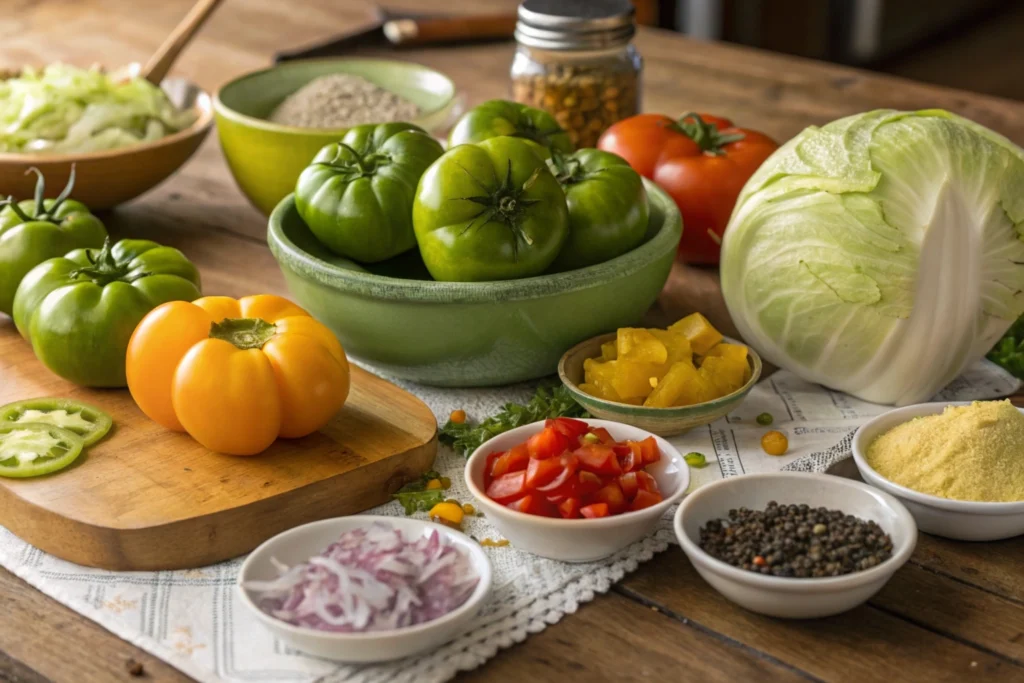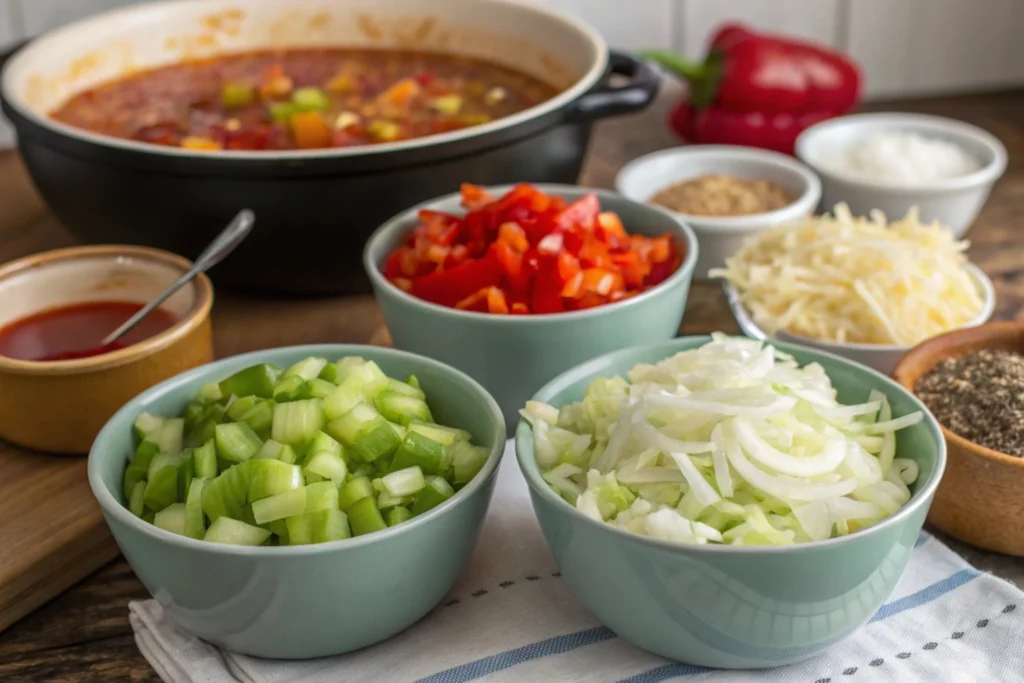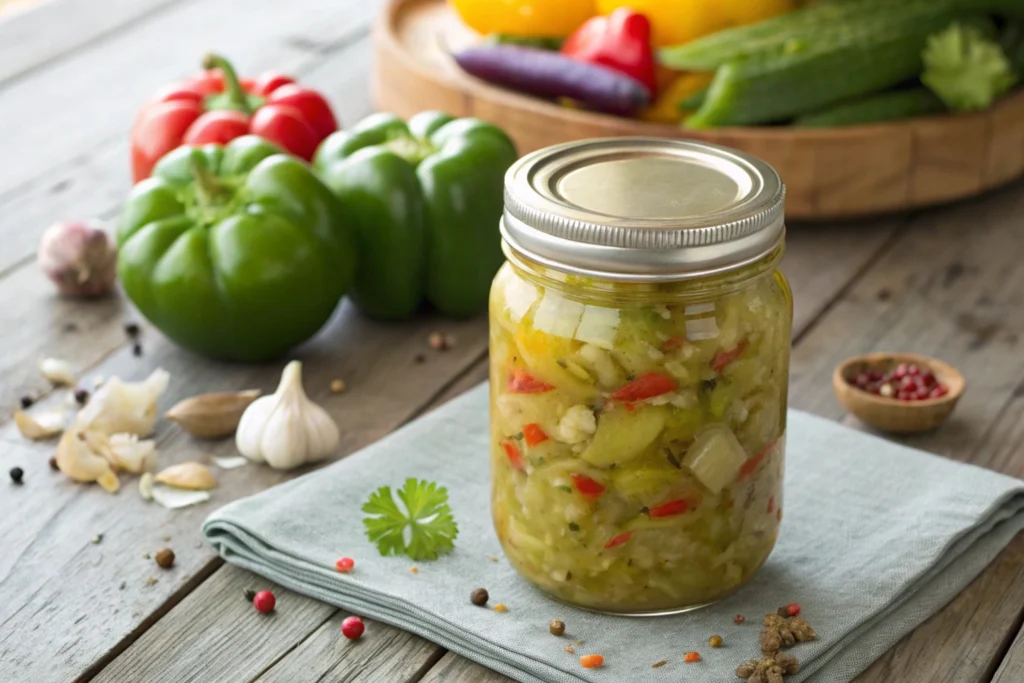Southern chow chow is more than a condiment. It’s a slice of tradition and a culinary keepsake passed down through generations in Southern kitchens. Bursting with tangy, sweet, and spicy flavors, chow chow relish serves as a vibrant symbol of Southern culture. This article explores its origins, ingredients, preparation methods, and the role it plays in Southern cuisine and beyond.
Whether you’re new to green tomato relish or already familiar with it, this guide covers everything about chow chow in the South. Let’s take a savory journey through history, flavors, and uses of this beloved relish.
Introduction to Southern Chow Chow
What is Chow Chow in the South?
Chow chow is a versatile pickled vegetable relish. Popular in the Southern United States, it combines finely chopped cabbage, green tomatoes, onions, and bell peppers, seasoned with vinegar, sugar, and spices. Its sweet, sour, and slightly spicy flavors make it a favorite topping for pinto beans and grilled meats.
While chow chow is a staple of Appalachian cuisine, its appeal extends far beyond. Every jar tells a story of innovation and resourcefulness, using end-of-season vegetables to create something extraordinary.
Historical Origins of Southern Chow Chow
The exact origins of chow chow remain mysterious, but historians trace its roots to the blending of European pickling techniques and African seasoning traditions brought to the Southern United States. Early settlers and enslaved people combined available ingredients to craft recipes that families have lovingly preserved through generations.
Interestingly, chow chow bears similarities to piccalilli, a British relish that likely influenced its development. Over time, Southerners adapted it to their tastes, incorporating local produce and spices to craft the version we know today.
Regional Variations of Chow Chow
Across the South, chow chow takes on a variety of forms. In some areas, it’s sweeter, with a heavier emphasis on sugar, while in others, it carries a vinegary punch. Some families add hot peppers for an extra kick, while others keep it mild. These regional differences not only reflect individual tastes but also the diverse cultural influences that shape Southern cuisine.
For instance, Appalachian households often pair chow chow with soup beans to create a hearty, satisfying meal. Meanwhile, in Louisiana, you might find spicier versions that reflect the influence of Cajun and Creole flavors. Regardless of the variation, one thing remains constant: chow chow’s ability to elevate any dish it accompanies.
Ingredients and Preparation
Common Ingredients in Southern Chow Chow

The beauty of Southern chow chow lies in its simplicity and the vibrancy of its ingredients. Each component plays a crucial role in creating the perfect balance of flavors. At its heart, chow chow reflects both creativity and practicality, as cooks often make this vegetable medley using end-of-season produce.
The primary ingredients typically include:
- Green Tomatoes: The star of most chow chow recipes, these tart fruits provide a tangy backbone.
- Cabbage: Adds crunch and body to the relish, making it a satisfying texture complement to softer dishes.
- Bell Peppers: Cooks use both green and red varieties to add sweetness, crunch, and a pop of color.
- Onions: Their sharpness rounds out the flavor profile with a bit of bite.
- Hot Peppers: Optional but often included to give chow chow its signature kick.
Cooks elevate these vegetables with a mix of spices, typically including mustard seed, turmeric, and celery seed. Vinegar lends acidity, while sugar brings a subtle sweetness, ensuring each bite is a harmonious blend of contrasts.
What’s exciting is how customizable chow chow can be. Families across the South often tweak recipes, incorporating local ingredients or adding unique touches like garlic, ginger, or even apple cider vinegar.
Traditional Preparation Methods

Making traditional chow chow at home is a labor of love, but the result is worth every effort. Here’s how it’s typically done:
- Vegetable Preparation: Start by finely chopping all vegetables, aiming for uniform pieces for a consistent texture. A food processor can help save time without sacrificing quality.
- Seasoning the Mix: In a large bowl, toss the vegetables with salt and let them sit for several hours or overnight. This process draws out excess moisture, ensuring a firm and flavorful final product.
- Cooking the Relish: Combine the salted vegetables with a mixture of vinegar, sugar, and spices in a large pot. Bring the mixture to a simmer, allowing the vegetables to soften and the flavors to meld.
- Sterilizing Jars: Ensure you properly sterilize your jars and lids before filling them to prevent contamination and spoilage.
- Filling and Sealing: Ladle the hot chow chow into jars, leaving about half an inch of headspace. Wipe the rims clean, then seal tightly with sterilized lids.
- Processing the Jars: For long-term storage, process the jars in a boiling water bath for about 15 minutes. This step ensures a secure seal and helps preserve the relish for up to a year.
By following these steps, you can create a batch of chow chow that captures the essence of Southern cuisine while honoring its time-tested methods.
Canning and Preservation Techniques
Preserving chow chow lets people savor this vibrant relish all year long, well beyond the end of the growing season. The process, while meticulous, is straightforward and rewarding.
- The Water Bath Method: The most common technique, this involves submerging filled jars in boiling water for a set amount of time. The heat not only sterilizes the contents but also creates a vacuum seal that prevents spoilage.
- Refrigeration for Short-Term Use: If you plan to consume chow chow within a month or two, you can skip the water bath process. Simply store the jars in the refrigerator after they cool.
- Freezing: For an unconventional but effective method, freeze chow chow in airtight containers to preserve its freshness. This works well if you lack the equipment for traditional canning.
To maximize flavor and texture, always label your jars with the date and batch details. Properly canned chow chow can last up to 12 months in a cool, dark place. With every jar opened, you’re unlocking the flavors of the South, preserved perfectly for future enjoyment.
Culinary Uses and Pairings
Serving Suggestions for Chow Chow
The versatility of chow chow relish is one of its greatest charms. It can transform an ordinary meal into something extraordinary with just a dollop. Here are some of the best ways to enjoy it:
- Classic Pairings: The most traditional use of chow chow is as a topping for pinto beans. This combination is a staple in Southern households, where the tangy relish brightens the hearty, earthy flavors of the beans. It’s equally delicious with black-eyed peas or collard greens.
- On Sandwiches and Burgers: Spread chow chow on a sandwich for a burst of flavor, or use it as a condiment on burgers to elevate your grilling game.
- As a Side Dish: Many Southern households serve chow chow alongside barbecue or smoked meats. Its acidity cuts through the richness of pork ribs, brisket, or chicken.
- Taco Topping: A modern twist includes using chow chow as a vibrant topping for tacos, where its tang complements spicy fillings like pulled pork or roasted veggies.
- With Cheeses and Charcuterie: Chow chow pairs wonderfully with creamy cheeses like brie or goat cheese, adding complexity to a charcuterie board.
The beauty of chow chow is its adaptability. Whether you’re hosting a backyard barbecue or looking for a quick way to liven up your leftovers, this relish adds both zest and charm.
Chow Chow in Southern Dishes
Chow chow is more than a condiment; it’s an essential ingredient in many traditional Southern dishes. Let’s explore some iconic recipes where chow chow shines:
- Soup Beans with Chow Chow: A humble yet hearty meal, this Appalachian favorite pairs savory soup beans with a heaping spoonful of chow chow for a tangy, flavorful contrast.
- Fried Catfish and Chow Chow: In the Deep South, people often pair crispy fried catfish with chow chow on the side. The relish’s acidity cuts through the richness of the fish.
- Pulled Pork Sandwiches: Pulled pork sandwiches, a Southern barbecue staple, become even better with a topping of chow chow, adding crunch and a burst of flavor.
- Deviled Eggs with Chow Chow Garnish: A creative spin on a classic appetizer, deviled eggs topped with a dollop of chow chow offer a delightful blend of creamy and tangy.
- Vegetable Plates: Many Southern “meat and three” restaurants serve chow chow alongside a plate of vegetables, where it adds an exciting layer of flavor to simple sides like mashed potatoes or roasted squash.
By incorporating chow chow into these dishes, you not only honor its Southern roots but also discover its ability to bring new life to everyday meals.
Health Benefits of Chow Chow
Southern chow chow is celebrated not only for its flavor but also for its surprising nutritional benefits. Thanks to its vegetable-packed recipe, chow chow offers several perks for health-conscious eaters:
- Rich in Vitamins: Ingredients like cabbage, bell peppers, and onions are excellent sources of vitamins C and K, which support immune function and bone health.
- Low in Calories: Chow chow is naturally low in calories, making it a guilt-free addition to most meals. It provides a punch of flavor without contributing to weight gain.
- High in Antioxidants: Vegetables used in chow chow contain antioxidants, which can help protect cells from damage caused by free radicals.
- Promotes Digestive Health: The vinegar used in chow chow can aid digestion, while the fiber content from the vegetables supports a healthy gut.
Many consider chow chow a comfort food, but its nutritional profile also makes it a smart choice for those looking to balance indulgence with health benefits.e also makes it a smart choice for those looking to balance indulgence with health benefits. By savoring a spoonful of this flavorful relish, you’re treating both your taste buds and your body.
Cultural Significance and Modern Adaptations
Chow Chow in Southern Traditions
In the South, chow chow relish is more than a condiment—it’s a symbol of resourcefulness, community, and celebration. For generations, families have gathered in late summer or early fall to prepare chow chow, transforming surplus garden vegetables into a preserved treasure to share throughout the year. These gatherings often became social events, where recipes and stories were passed down, strengthening familial bonds.
Chow chow has also cemented its place in regional traditions. It’s a staple at Southern potlucks and picnics, where it’s served alongside everything from fried chicken to cornbread. It frequently makes an appearance at holiday dinners, adding a splash of vibrant flavor to festive spreads. In some Appalachian communities, chow chow has even been a prizewinner in local fairs, celebrated as a hallmark of homegrown culinary talent.
The cultural significance of chow chow extends to its representation of Southern thrift. It epitomizes the art of using every part of a harvest, ensuring nothing goes to waste—a practice deeply ingrained in the agrarian history of the South.
Modern Twists on Traditional Chow Chow
While traditional chow chow recipes remain beloved, contemporary cooks have embraced the opportunity to innovate, resulting in exciting modern variations. Today’s chow chow may include unconventional ingredients, creative spice blends, or even non-traditional uses.
- Creative Ingredients: Some cooks incorporate fruits like apples or peaches to add a subtle sweetness, while others experiment with unique vegetables like cauliflower or zucchini.
- Fusion Flavors: Modern chefs are blending the traditional Southern relish with influences from other cuisines. For instance, chow chow with ginger and soy offers an Asian-inspired twist.
- Specialty Spices: Adding smoked paprika, chipotle, or even curry powder gives chow chow a unique depth of flavor, catering to more adventurous palates.
- Vegan-Friendly Recipes: Many modern recipes ensure that chow chow is entirely plant-based, making it a hit with those following vegan or vegetarian diets.
These adaptations reflect how chow chow continues to evolve, appealing to both traditionalists and those seeking to experiment. Despite these innovations, the essence of chow chow—its tangy, vibrant flavor—remains intact.
Chow Chow Outside the South
Once considered a strictly Southern specialty, chow chow relish has gained popularity far beyond its regional roots. In part, this spread is thanks to the rise of food enthusiasts and chefs championing Southern cuisine on a national stage. Restaurants across the United States are introducing diners to chow chow as an accompaniment to gourmet dishes, from grilled seafood to artisanal charcuterie boards.
Additionally, chow chow has found a home in the growing interest in pickling and fermentation, which has captivated food lovers worldwide. As a result, variations of chow chow are now appearing in farmers’ markets and specialty food shops far beyond the South, each jar bringing a taste of Southern tradition to a wider audience.
Even internationally, chow chow has piqued interest. In countries where pickled relishes are already a culinary staple, chow chow is embraced as a cousin to local favorites. For example, its tangy profile resonates with fans of chutneys and preserved vegetables in Indian, British, and Caribbean cuisines.
As it finds new admirers, chow chow remains a testament to the power of humble ingredients, offering a taste of Southern heritage in every bite.
Frequently Asked Questions
What is chow chow in the South?
Chow chow relish is a vibrant and tangy condiment made from pickled vegetables such as green tomatoes, cabbage, and bell peppers. It’s a staple in Southern cuisine, often served alongside beans, meats, and greens to add a zesty burst of flavor. This relish embodies the resourcefulness of the South, using end-of-season produce to create something delicious and enduring.
How is chow chow traditionally made?
The traditional preparation of Southern chow chow involves finely chopping a variety of vegetables like cabbage, onions, and tomatoes. These are then seasoned with a mix of vinegar, sugar, and spices such as mustard seed and turmeric. The mixture is cooked until the flavors meld beautifully, then packed into sterilized jars and preserved through a water bath canning process. This method ensures chow chow can be enjoyed for months or even a year.
What dishes pair well with chow chow?
Chow chow pairs wonderfully with a range of Southern dishes. It’s often served atop pinto beans or black-eyed peas, adding tanginess and texture. It complements barbecued meats like pulled pork or ribs and works as a topping for sandwiches and hot dogs. For those seeking modern pairings, chow chow shines on tacos, burgers, or even as a garnish for roasted vegetables.
How long does homemade chow chow last?
When properly canned using the boiling water bath method, homemade chow chow can last up to a year if stored in a cool, dark place. Once opened, it should be refrigerated and consumed within one to two months. For short-term use, refrigerating chow chow immediately after preparation (without canning) will keep it fresh for about four weeks.
Can chow chow recipes be customized?
Absolutely! One of the joys of making chow chow is its versatility. Recipes can be adjusted to suit individual tastes by adding extra spices, tweaking the ratio of vinegar to sugar, or including unique ingredients like jalapeños, carrots, or even fruits such as peaches. Every family or region often has its own special twist on the traditional recipe.
Is chow chow the same as piccalilli?
While chow chow and piccalilli are both pickled relishes, they are not identical. Chow chow is a Southern staple made primarily with green tomatoes, cabbage, and other vegetables, whereas piccalilli is of British origin and often includes mustard, turmeric, and cauliflower. Piccalilli tends to be more pungent and spicy compared to the milder, tangier flavor of chow chow.
Conclusion
The Enduring Legacy of Southern Chow Chow
Chow chow relish isn’t just a food—it’s a cultural emblem that connects generations, regions, and traditions. In the South, this tangy and versatile condiment tells the story of resourcefulness and community. It has thrived not only as a beloved sidekick to iconic dishes like pinto beans and barbecue but also as a reflection of the Southern spirit of making the most of what’s available.
For many, a jar of chow chow represents more than its ingredients; it’s a nostalgic reminder of family recipes, shared meals, and the comfort of home. From small-town kitchens to upscale restaurants, chow chow continues to hold a cherished place in the culinary landscape.
Encouragement to Explore Chow Chow Recipes
If you’ve never tried making or tasting Southern chow chow, there’s no better time to start. Its preparation, while rooted in tradition, is simple enough for modern cooks to master. Experimenting with ingredients and spice blends allows you to put your own stamp on this classic relish, ensuring it becomes part of your kitchen repertoire.
Whether you’re seeking to embrace Southern culinary traditions or looking for a flavorful new addition to your meals, chow chow offers endless possibilities. You might be surprised at how quickly this zesty relish becomes a household favorite!
Final Thoughts on Chow Chow’s Place in Modern Cuisine
As food trends evolve, chow chow has shown an impressive ability to adapt and flourish in contemporary kitchens. Its mix of bold flavors appeals to modern palates, while its humble origins resonate with those seeking authenticity in their meals. Whether served in a traditional Southern dish or reimagined in fusion cuisine, chow chow remains a vibrant and essential part of America’s culinary heritage.
By exploring chow chow in the South, you’re diving into a flavorful history that bridges the past and present, creating connections through food that are as enduring as they are delicious.

